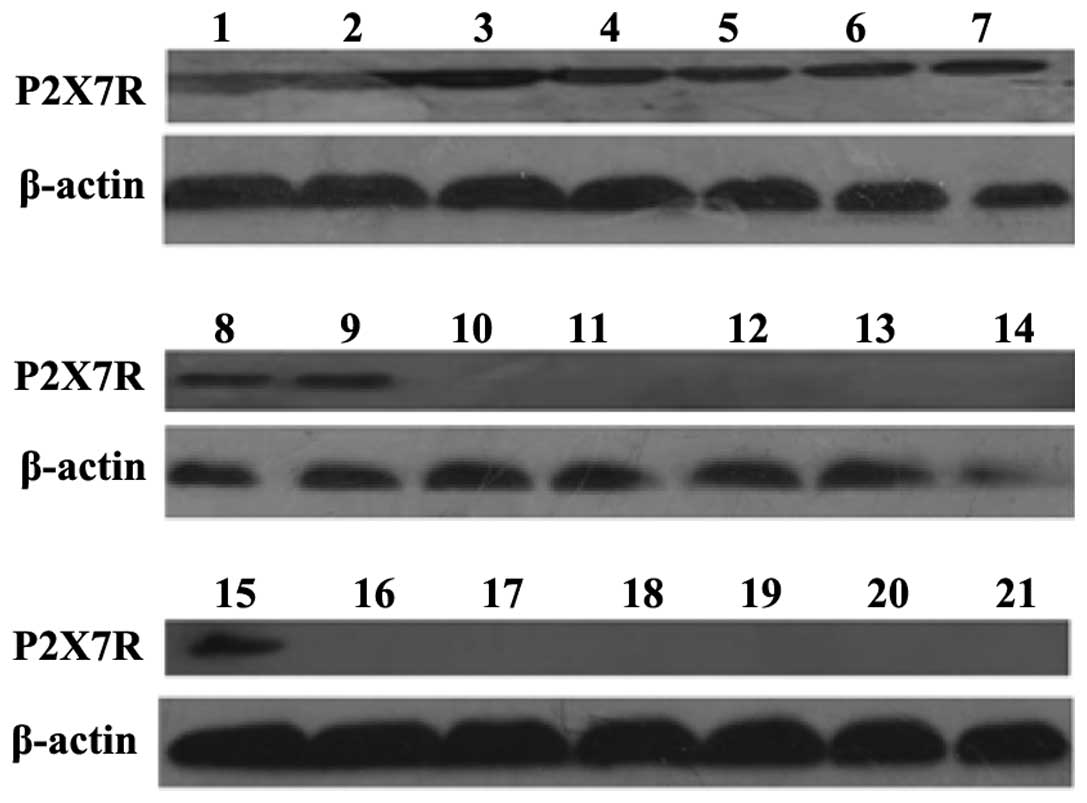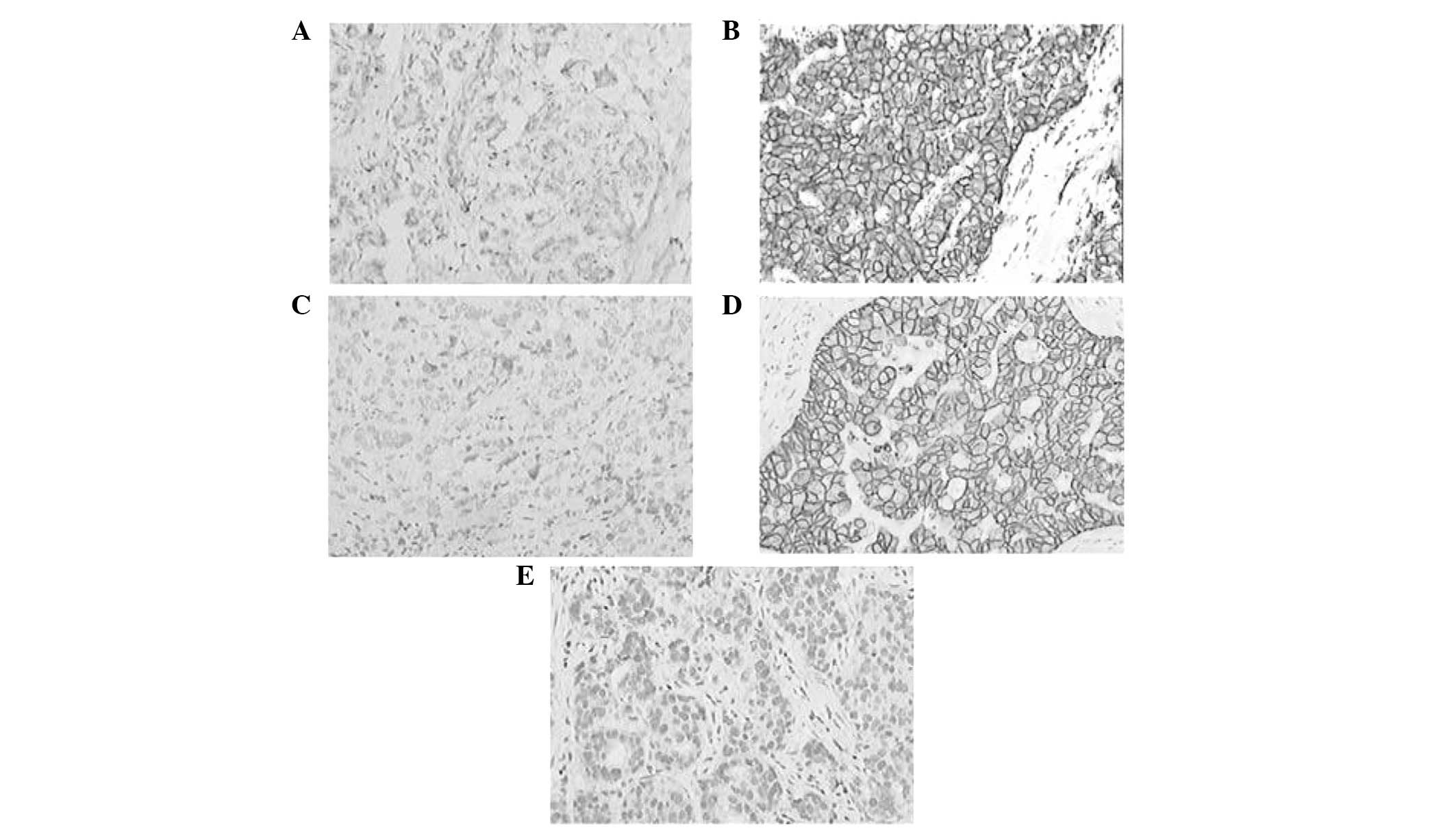Expression of P2X7R in breast cancer tissue and the induction of apoptosis by the gene-specific shRNA in MCF-7 cells
- Authors:
- Chao Tan
- Li Han
- Lili Zou
- Chunhua Luo
- Aihua Liu
- Xiejing Sheng
- Dee Xi
-
View Affiliations
Affiliations: Institute of Molecular Biology, Medical College, China Three Gorges University, Yichang, Hubei 443002, P.R. China, First Affiliated Hospital of China Three Gorges University, Yichang, Hubei 443000, P.R. China
- Published online on: August 24, 2015 https://doi.org/10.3892/etm.2015.2705
-
Pages:
1472-1478
Metrics:
Total
Views: 0 (Spandidos Publications: | PMC Statistics:
)
Metrics:
Total PDF Downloads: 0 (Spandidos Publications: | PMC Statistics:
)
This article is mentioned in:
Abstract
The aim of the present study was to investigate the effects of P2X7R short hairpin (sh)RNA on the proliferation and apoptosis of MCF-7 cells, and to detect the expression of P2X7R in breast cancer and MCF‑7 cells. In order to detect the expression of P2X7R in normal breast and breast cancer tissues, quantitative reverse transcription‑polymerase chain reaction (qRT‑PCR), western blot analysis and immunohistochemistry were performed. A P2X7‑targeted shRNA sequence and a scrambled sequence were inserted into the pLKO.1 expression vector, and MCF‑7 cells with stable transfection of P2X7R‑shRNA and P2X7R‑scrambled shRNA (control) were selected. qRT‑PCR was used to detect the mRNA expression levels of P2X7R in the MCF‑7 cells transfected with P2X7R‑shRNA and scrambled shRNA. In addition, protein expression levels of P2X7R in the fresh tumor tissues were detected by western blot analysis. An MTT assay was used to detect the proliferation rate at different time points, while flow cytometry was used to detect the growth inhibition and apoptosis rate of the stably transfected MCF‑7 cells. P2X7R expression levels in the breast cancer tissues were higher when compared with the normal breast tissue, and a positive correlation was observed with the estrogen receptor (ER+), as shown by qRT‑PCR, western blot analysis and immunohistochemistry. Plasmids expressing P2X7 gene‑specific shRNA and scrambled shRNA were constructed and transfected into MCF‑7 cells. The qRT‑PCR results revealed lower mRNA expression levels of P2X7 in the P2X7R‑shRNA cells when compared with the scrambled shRNA cells. Furthermore, western blot analysis demonstrated that P2X7 protein was highly expressed in the MCF‑7 cells transfected with scrambled shRNA, while low expression was observed in the P2X7R‑shRNA‑transfected cells. Following transfection of the recombinant plasmids into the MCF‑7 cells, the proliferation rate in each group was analyzed. The P2X7R‑shRNA and KN‑62 groups were shown to have significantly reduced rates of proliferation when compared with the normal control group. In addition, flow cytometry revealed that the P2X7R‑shRNA and KN‑62 groups exhibited a reduced level of cell proliferation and a higher rate of apoptosis. In conclusion, P2X7R was shown to be overexpressed in breast cancer tissues and positively associated with ER expression. A P2X7R‑shRNA expression vector effectively inhibited P2X7R expression in MCF‑7 breast cancer cells, which subsequently induced cell apoptosis and reduced the levels of cell proliferation. These results indicated that P2X7R may serve as a potential target for breast cancer treatment and prevention.
View Figures |
Figure 1
|
 |
Figure 2
|
 |
Figure 3
|
 |
Figure 4
|
 |
Figure 5
|
 |
Figure 6
|
 |
Figure 7
|
View References
|
1
|
Díez-Zaera M, Díaz-Hernández JI,
Hernández-Álvarez E, et al: Tissue-nonspecific alkaline phosphatase
promotes axonal growth of hippocampal neurons. Mol Biol Cell.
22:1014–1024. 2011. View Article : Google Scholar : PubMed/NCBI
|
|
2
|
Agrawal A and Gartland A: P2X7 receptors:
Role in bone cell formation and function. J Mol Endocrinol.
54:R75–R88. 2015. View Article : Google Scholar : PubMed/NCBI
|
|
3
|
North RA: Molecular physiology of P2X
receptors. Physiol Rev. 82:1013–1067. 2002. View Article : Google Scholar : PubMed/NCBI
|
|
4
|
Di Virgilio F: P2X receptors and
inflammation. Curr Med Chem. 22:866–877. 2015. View Article : Google Scholar : PubMed/NCBI
|
|
5
|
Gartland A, Skarratt KK, Hocking LJ,
Parsons C, Stokes L, Jørgensen NR, Fraser WD, Reid DM, Gallagher JA
and Wiley JS: Polymorphisms in the P2X7 receptor gene are
associated with low lumbar spine bone mineral density and
accelerated bone loss in post-menopausal women. Eur J Hum Genet.
20:559–564. 2012. View Article : Google Scholar : PubMed/NCBI
|
|
6
|
Gutiérrez-Martín Y, Bustillo D,
Gómez-Villafuertes R, et al: P2X7 receptors trigger ATP exocytosis
and modify secretory vesicle dynamics in neuroblastoma cells. J
Biol Chem. 286:11370–11381. 2011. View Article : Google Scholar : PubMed/NCBI
|
|
7
|
Ferrari D, Pizzirani C, Adinolfi E, et al:
The P2X7 receptor: A key player in IL-1 processing and release. J
Immunol. 176:3877–3883. 2006. View Article : Google Scholar : PubMed/NCBI
|
|
8
|
MacKenzie A, Wilson HL, Kiss-Toth E, et
al: Rapid secretion of interleukin-1beta by microvesicle shedding.
Immunity. 15:825–835. 2001. View Article : Google Scholar : PubMed/NCBI
|
|
9
|
Pelegrin P and Surprenant A: The P2X(7)
receptor-pannexin connection to dye uptake and IL-1beta release.
Purinergic Signal. 5:129–137. 2009. View Article : Google Scholar : PubMed/NCBI
|
|
10
|
Nazıroğlu M, Tokat S and Demirci S: Role
of melatonin on electromagnetic radiation-induced oxidative stress
and Ca2+ signaling molecular pathways in breast cancer.
J Recept Signal Transduct Res. 32:290–297. 2012. View Article : Google Scholar : PubMed/NCBI
|
|
11
|
Sambrook J and Russell DW; Huang PT:
Molecular Cloning: A Laboratory Manual (3rd). Cold Spring Harbor
Laboratory Press. NY: 1474–1480. 2001.
|
|
12
|
Oran ES, Yankol Y, Soybir GR, et al:
Distinct postsurgical management in young and elderly breast cancer
patients results in equal survival rates. Asian Pac J Cancer Prev.
15:7843–7847. 2014. View Article : Google Scholar : PubMed/NCBI
|
|
13
|
Iversen A, Thune I, McTiernan A, et al:
Ovarian hormones and reproductive risk factors for breast cancer in
premenopausal women: The Norwegian EBBA-I study. Hum Reprod.
26:1519–1529. 2011. View Article : Google Scholar : PubMed/NCBI
|
|
14
|
Uzgiris EE: A cell-surface polymer
reptation mechanism for tumor transendothelial transport of
macromolecules. Technol Cancer Res Treat. 7:257–268. 2008.
View Article : Google Scholar : PubMed/NCBI
|
|
15
|
Qu Y, Misaghi S, Newton K, et al:
Pannexin-1 is required for ATP release during apoptosis but not for
inflammasome activation. J Immunol. 186:6553–6561. 2011. View Article : Google Scholar : PubMed/NCBI
|
|
16
|
Iyer AK, Singh A, Ganta S and Amiji MM:
Role of integrated cancer nanomedicine in overcoming drug
resistance. Adv Drug Deliv Rev. 65:1784–1802. 2013. View Article : Google Scholar : PubMed/NCBI
|
|
17
|
Cai Y, Wang H, Hou Y, et al: Study on the
effect of Klotho gene interferred by plasmid-mediated short hairpin
RNA (shRNA) on sinoatrial node pacing channel gene. Sheng Wu Yi Xue
Gong Cheng Xue Za Zhi. 30:588–591. 2013.(In Chinese). PubMed/NCBI
|

















